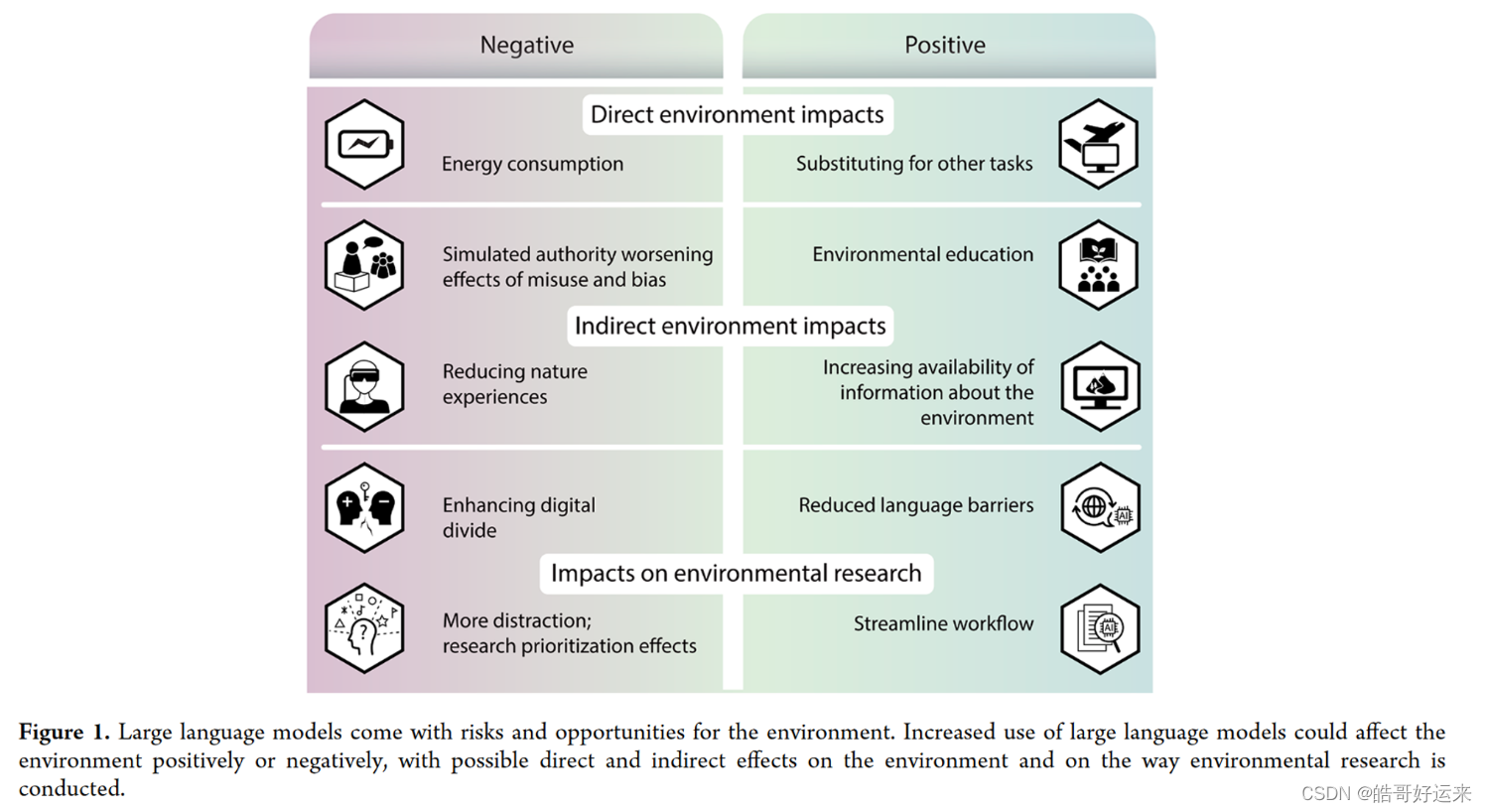【Datawhale 大模型基础】第十一章 环境影响
第十一章 环境影响
This blog is based on datawhale files and a paper.

The initial consideration revolves around the potential positive or negative direct impact on the environment. Other transformative technological advancements, like the metaverse, are likely to directly affect the environment through heightened energy consumption, leading to increased resource usage and carbon dioxide emissions. This concern extends to LLMs, as both their training and inference processes demand substantial energy, emphasizing the need for algorithmic efficiency. The carbon footprint will be influenced by the energy consumption and carbon intensity of the energy source utilized. Furthermore, apart from carbon dioxide emissions, the computational facilities may also exert other environmental effects, such as water usage and soil pollution or sealing, which could have broader implications for environmental quality. On the other hand, it remains uncertain whether text-based chats in the future could partially substitute for video conferences or in-person meetings, which might otherwise entail greater resource consumption.
The increased use of LLMs may have important indirect consequences. One concern is the artificial expertise that LLM output appears to possess due to the extensive training data and polished language. This can lead to confusion with expert opinions, despite LLMs having limited ability to judge information reliability and relevance, partly due to their lack of natural language understanding. This can result in the creation of false output, as observed by those familiar with these apps in their own areas of expertise. Additionally, there is the potential for bias to be introduced at three points: the training data, the algorithm, and the form of output. Special interest groups and networks could exploit LLMs’ efficiency to generate text, potentially spreading misinformation under the guise of “artificial intelligence” and inundating public spaces with it.
However, unintentionally, the existing biases on complex environmental topics, such as environmental racism, climate change, biodiversity loss, and pollution, could be perpetuated and amplified by the training data used by LLMs. Conversely, creating informative content about environmental issues by individuals interested in environmental education could be made more efficient through LLMs. For instance, materials for environmental education could be more easily tailored for various target groups, such as different ages or educational levels.
LLM-based apps could either worsen or improve the digital gap within and between societies. These tools could further benefit those with good access to environmental information. On the positive side, LLMs could increase people’s involvement in environmental discussions, especially as they are offered in various languages. By providing a tool to improve their English scientific writing, LLMs could help more researchers from non-English speaking countries participate in environmental sciences.
However, relying more on technology-guided interactions could lead to fewer experiences in nature, potentially affecting how people appreciate biodiversity and ecosystems. On the other hand, the public could gain from unprecedented, current, accessible, and personalized information and educational opportunities on environmental issues. This could spark greater interest in environmental topics, thus improving environmental knowledge.
LLMs have many benefits for environmental science research, such as streamlining workflow and improving writing quality. However, there are concerns about potential distractions and misuse. It’s important to discuss these issues early and protect LLMs from undue influence. Governments and organizations should create policies to ensure unbiased information and increase literacy in LLM use.
END
本文来自互联网用户投稿,该文观点仅代表作者本人,不代表本站立场。本站仅提供信息存储空间服务,不拥有所有权,不承担相关法律责任。 如若内容造成侵权/违法违规/事实不符,请联系我的编程经验分享网邮箱:chenni525@qq.com进行投诉反馈,一经查实,立即删除!
- Python教程
- 深入理解 MySQL 中的 HAVING 关键字和聚合函数
- Qt之QChar编码(1)
- MyBatis入门基础篇
- 用Python脚本实现FFmpeg批量转换
- re:从0开始的HTML学习之路 0.编辑器安装配置、HTML标准结构生成
- java中list,map习题
- 04--JdbcTemplate模版
- Unity关于纹理图片格式带来的内存问题和对预制体批量格式和大小减半处理
- GIT中一些常用命令
- 基于YOLOv8 + BotSORT实现球员和足球检测与跟踪 (步骤 + 源码)
- 【计算机四级(网络工程师)笔记】操作系统概论
- 简单的通讯录项目的实现
- 51单片机_电压采集器&电压表
- go 语言中的别名类型